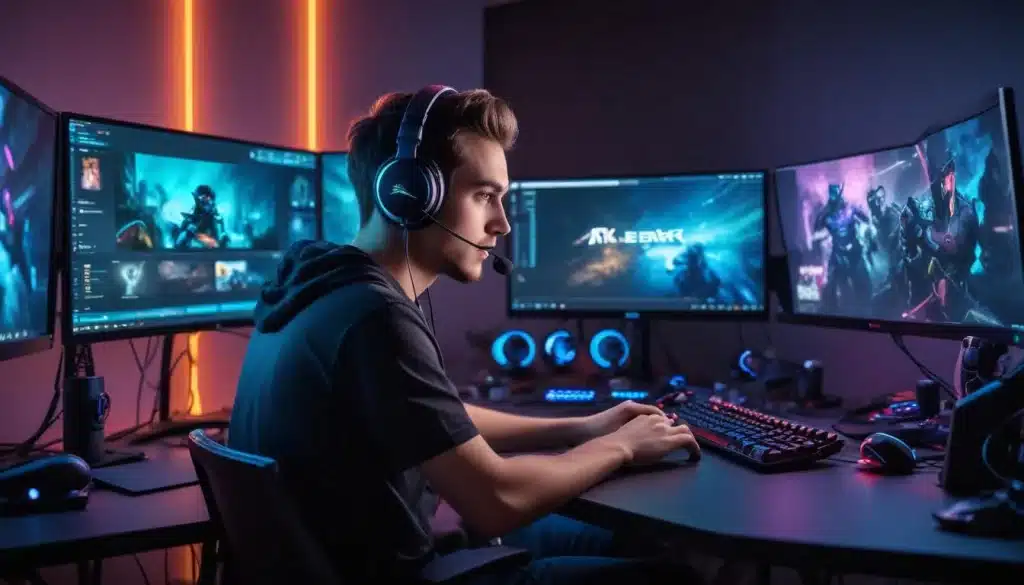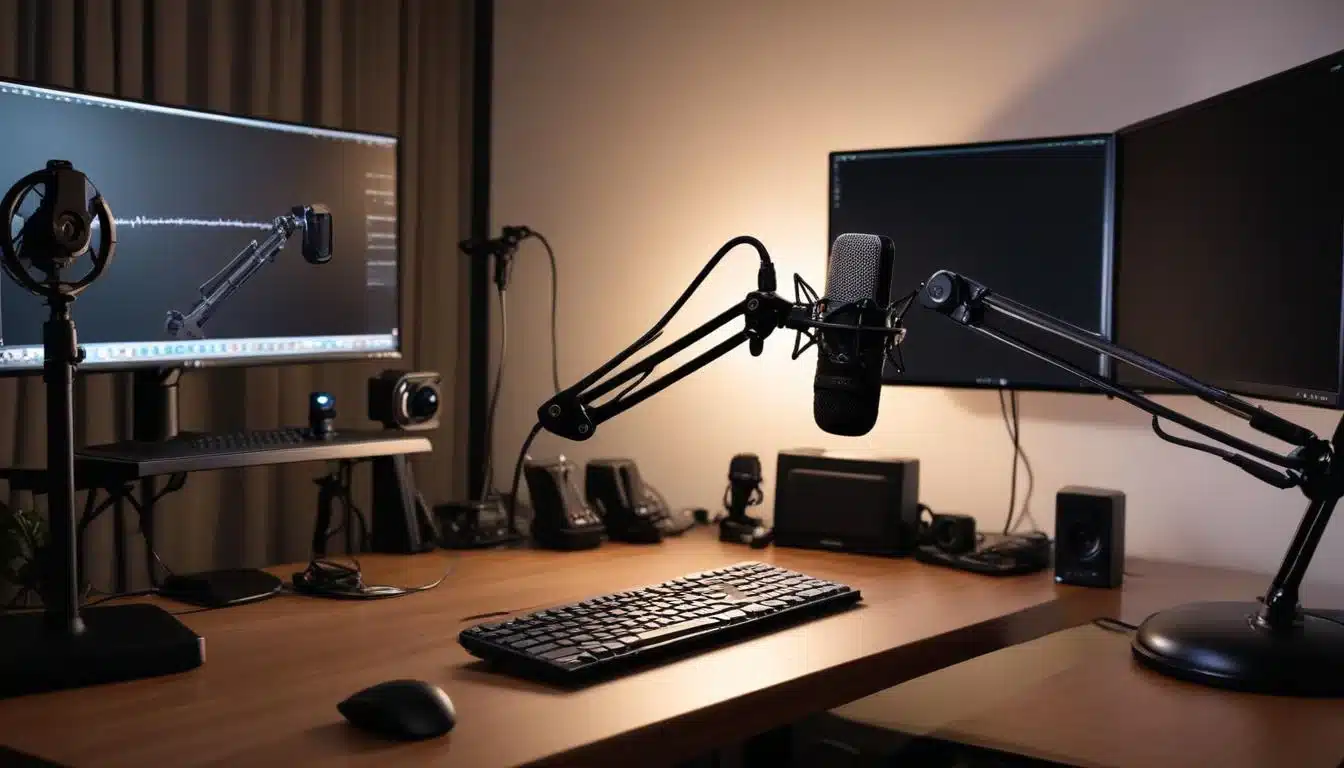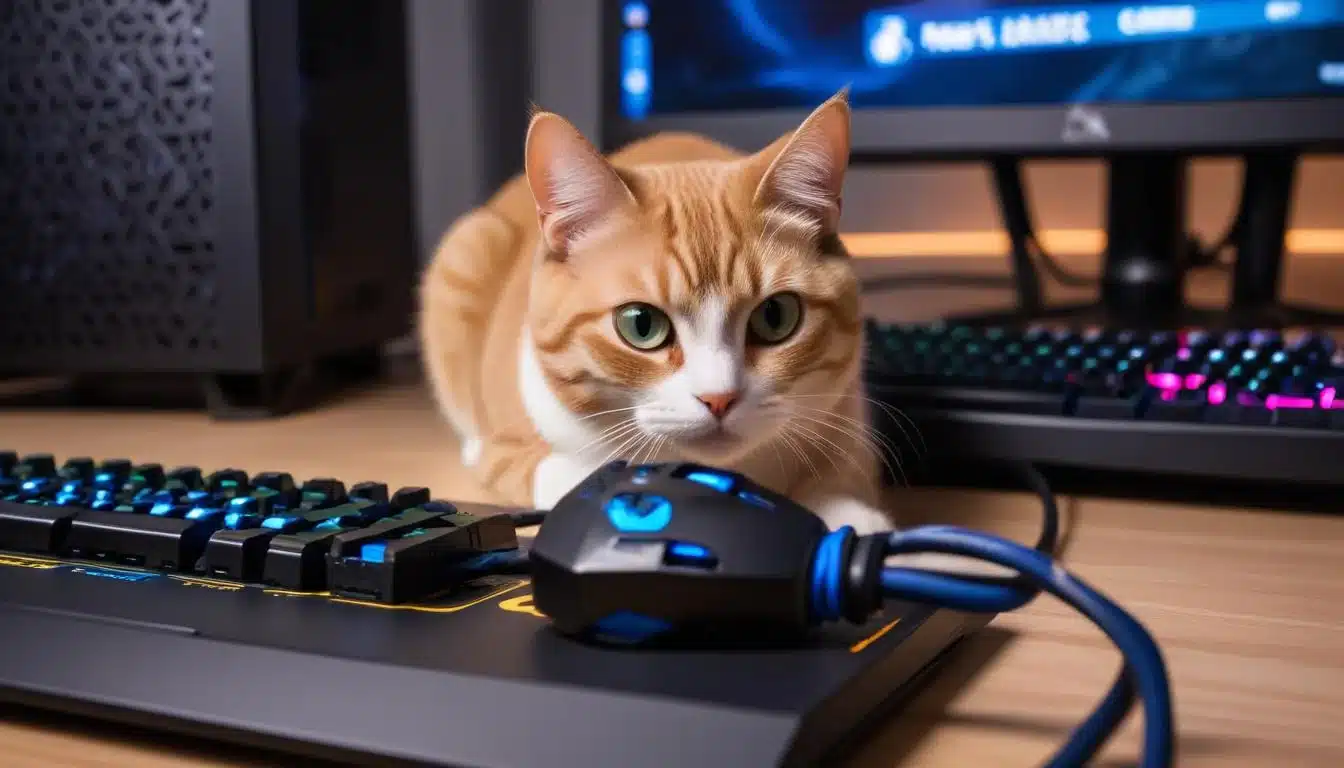PC Game Streaming: High-Quality Broadcasts in 5 Steps

Achieving high-quality PC game streaming involves optimizing hardware, configuring software, fine-tuning internet settings, engaging viewers effectively, and consistently monitoring performance for a superior broadcast experience.
Embarking on the journey of PC game streaming guide can be both exciting and daunting. The allure of sharing your gaming prowess and personality with a live audience is undeniable, yet the technical complexities often deter aspiring broadcasters. This comprehensive guide is designed to demystify the process, offering a clear, step-by-step approach to not only get you started but to help you achieve professional-grade, high-quality broadcasts that captivate your viewers.
Understanding the Core Components of a Quality Stream
Before diving into the practical steps, it’s crucial to grasp the fundamental elements that contribute to a high-quality PC game stream. It’s not just about having a powerful computer; it’s about a harmonious interplay of hardware, software, and network infrastructure. Each component plays a vital role in delivering a smooth, visually appealing, and engaging broadcast to your audience.
The foundation of any successful stream begins with a robust PC. This includes a capable processor, a dedicated graphics card, and sufficient RAM to handle both gaming and encoding simultaneously. Beyond the computer itself, peripherals such as a high-quality microphone and webcam are essential for personalizing your stream and connecting with viewers on a deeper level. Without these core components working in unison, even the most optimized software settings will struggle to produce a desirable outcome.
The Role of Hardware in Streaming Performance
Your PC’s specifications directly impact the quality and stability of your stream. A powerful CPU is responsible for encoding your video, transforming raw game footage into a compressed format suitable for transmission. A strong GPU ensures that your game runs smoothly at high frame rates, which is crucial for a pleasant viewing experience. Insufficient hardware can lead to dropped frames, pixelation, and a generally choppy stream, frustrating both you and your audience.
- Processor (CPU): A multi-core CPU (e.g., Intel i7/i9 or AMD Ryzen 7/9) is recommended for efficient video encoding without impacting game performance.
- Graphics Card (GPU): A modern, dedicated GPU (e.g., NVIDIA RTX series or AMD Radeon RX series) ensures high frame rates in-game and can assist with encoding.
- RAM: 16GB of DDR4 RAM is generally the minimum recommended for smooth gaming and streaming simultaneously, with 32GB offering more headroom.
- Storage: An SSD (Solid State Drive) for your operating system and games significantly reduces load times and improves overall system responsiveness.
Understanding these hardware considerations is the first step toward building a reliable streaming setup. Investing in quality components upfront can save you considerable headaches down the line, ensuring a more consistent and higher-quality broadcast for your viewers. The synergy between these parts is what ultimately dictates the ceiling of your streaming potential.
Step 1: Optimizing Your PC Hardware and Internet Connection
The bedrock of any high-quality stream is a finely tuned PC and a stable internet connection. Neglecting these fundamental aspects can lead to frustrating performance issues, regardless of your software configurations. This step focuses on ensuring your system is ready to handle the demands of both gaming and broadcasting simultaneously.
Begin by checking your PC’s specifications against the recommended requirements for streaming. Most modern games are resource-intensive, and adding the burden of live encoding requires substantial processing power. An outdated or underpowered machine will struggle, resulting in a poor viewing experience with low frame rates and pixelated video. Regular maintenance, such as updating drivers and clearing temporary files, also contributes to optimal performance.
Ensuring Sufficient Processing Power
Your CPU and GPU are the workhorses of your streaming setup. The CPU handles the encoding of your video feed, converting it into a streamable format, while the GPU renders your game. For high-quality streams, especially at 1080p or higher resolutions, you’ll need a powerful multi-core processor. Modern GPUs also offer dedicated encoding chips (like NVIDIA’s NVENC or AMD’s AMF) that can offload this task from your CPU, significantly improving performance.
- CPU Upgrade: Consider an Intel Core i7 (10th gen or newer) or AMD Ryzen 7 (3000 series or newer) for balanced performance.
- GPU Upgrade: NVIDIA RTX 20-series or newer, or AMD Radeon RX 5000-series or newer, provide excellent gaming and encoding capabilities.
- Driver Updates: Always keep your graphics card drivers up to date for the latest performance enhancements and bug fixes.
Stabilizing Your Internet Connection
A fast and, more importantly, stable internet connection is paramount for streaming. While download speeds are crucial for gaming, upload speeds are vital for sending your stream to platforms like Twitch or YouTube. A wired Ethernet connection is always preferred over Wi-Fi, as it offers greater stability and lower latency, minimizing dropped frames and buffering for your viewers.
Test your internet’s upload speed regularly using online speed tests. Aim for an upload speed of at least 5-10 Mbps for 1080p streams, though higher is always better for consistency. If your connection is inconsistent, consider contacting your internet service provider to explore options for improved stability or higher upload bandwidth. An unstable connection is a common culprit for choppy streams, leading to a frustrating experience for your audience.

Step 2: Choosing and Configuring Your Streaming Software
With your hardware optimized, the next critical step is selecting and properly configuring your streaming software. This software acts as your control center, capturing your game, webcam, and microphone, then encoding and sending it to your chosen streaming platform. The right software, correctly configured, is essential for a high-quality broadcast.
There are several popular streaming software options available, each with its own strengths. Open Broadcaster Software (OBS Studio) is a free, open-source, and highly customizable choice favored by many professional streamers. Streamlabs Desktop (formerly Streamlabs OBS) builds upon OBS with a more user-friendly interface and integrated alerts. XSplit Broadcaster is another powerful option, often used in professional broadcasting environments.
Setting Up OBS Studio for Optimal Performance
OBS Studio offers unparalleled control over your stream, making it a top choice for those aiming for high quality. The initial setup involves adding sources (game capture, webcam, microphone) and configuring output settings. The key is to find a balance between visual quality and your internet’s upload capacity, along with your PC’s encoding capabilities.
- Output Settings: Set your video bitrate based on your upload speed (e.g., 4500-6000 kbps for 1080p/60fps). Use a hardware encoder (NVENC H.264 or AMD H.264/HEVC) if available, as it significantly reduces CPU load.
- Video Settings: Match your base (canvas) resolution to your monitor’s resolution, and set your output (scaled) resolution to your desired stream resolution (e.g., 1920×1080 or 1280×720). Set your common FPS value to 60 or 30, depending on game and bandwidth.
- Audio Settings: Ensure your microphone and desktop audio devices are correctly selected and levels are balanced. Use noise gates and compression filters for clearer audio.
Properly configuring OBS Studio involves a bit of experimentation to find the sweet spot for your specific setup. Start with recommended settings and gradually adjust them based on your stream’s performance and viewer feedback. Regular testing is crucial to ensure everything is working as expected before going live.
Step 3: Enhancing Your Audio and Visual Presence
Beyond the technical backbone, the quality of your audio and visual presentation significantly impacts viewer engagement. A crisp, clear voice and a well-lit, professional-looking webcam feed can elevate your stream from amateur to polished. This step focuses on optimizing these crucial elements to create a more immersive and appealing experience for your audience.
Many new streamers overlook the importance of good audio, yet it’s often cited as one of the most critical factors for viewer retention. Viewers are more forgiving of slightly less-than-perfect video quality than they are of muffled, distorted, or noisy audio. Investing in a decent microphone and learning basic audio processing techniques can make a world of difference. Similarly, a clear webcam feed helps build a connection, allowing viewers to see your reactions and personality.
Achieving Crystal-Clear Audio
A good microphone is a non-negotiable asset for any serious streamer. USB microphones like the Blue Yeti or Rode NT-USB Mini offer excellent quality for their price point, while XLR microphones paired with an audio interface provide professional-grade sound. Positioning your microphone correctly – typically a few inches from your mouth – is also vital for capturing your voice clearly and minimizing background noise.
- Microphone Choice: Invest in a dedicated condenser or dynamic microphone; avoid using headset mics for primary audio.
- Acoustic Treatment: Minimize echoes by adding soft furnishings, foam panels, or blankets to your streaming area.
- Software Filters: Utilize OBS Studio’s built-in audio filters such as noise suppression, noise gate, compressor, and limiter to refine your sound.
Optimizing Your Webcam and Lighting
Your webcam is your direct window to your audience. A high-definition webcam (1080p at 30 or 60fps) provides a clear image. However, even the best webcam benefits immensely from good lighting. Proper lighting can drastically improve image quality, making you look more vibrant and professional, and can even compensate for a less expensive camera.
Position your lighting sources to illuminate your face evenly, avoiding harsh shadows. Ring lights are popular among streamers for their ability to provide soft, diffuse light that eliminates shadows and adds a pleasing catchlight to your eyes. Experiment with different lighting setups to find what works best for your environment and personal aesthetic. A clean, uncluttered background also contributes to a professional appearance.

Step 4: Crafting Engaging Content and Interacting with Your Audience
Technical perfection is only half the battle; to truly succeed in PC game streaming, you must also be an entertainer. Crafting engaging content and fostering genuine interaction with your audience are paramount for building a loyal community. This step moves beyond technical configurations to focus on the human element of broadcasting.
Your personality is your unique selling point. Let it shine through your commentary, reactions, and interactions. While playing games is the core activity, remember that viewers are often there as much for you as they are for the gameplay. Develop a distinct style, whether it’s humor, educational insights, or competitive prowess, and be consistent in delivering it.
Developing Your Streaming Persona and Content Strategy
Think about what makes your stream unique. Are you a highly skilled player offering tips and tricks? Are you known for your comedic commentary? Or do you create a relaxed, community-focused environment? Defining your streaming persona helps you tailor your content and attract a specific audience. Plan your streams, but also leave room for spontaneity.
- Content Variety: While focusing on a main game, occasionally stream different titles or engage in non-gaming activities to keep content fresh.
- Schedule Consistency: Stream at regular times so your audience knows when to find you. Consistency builds anticipation and routine.
- Brand Identity: Develop unique overlays, alerts, and emotes that reflect your personality and make your stream recognizable.
Mastering Live Audience Interaction
The magic of live streaming lies in its interactivity. Engaging with your chat is crucial for building a community. Acknowledge new viewers, respond to questions, and react to comments. Even if you’re engrossed in gameplay, periodically check chat and make an effort to connect. Tools like Streamlabs or Nightbot can help manage chat and automate alerts, freeing you to focus more on interaction.
Beyond direct chat interaction, consider using polls, Q&As, or even inviting viewers to play games with you (if applicable). Create a welcoming environment where viewers feel comfortable participating. Remember, building a community takes time and consistent effort. Genuine interaction makes viewers feel valued and encourages them to return, transforming casual viewers into loyal fans.
Step 5: Monitoring Performance and Continuous Improvement
The journey to high-quality PC game streaming doesn’t end after your initial setup. Continuous monitoring and a commitment to improvement are essential for maintaining and enhancing your broadcast quality over time. Technology evolves, and so should your streaming practices. This final step emphasizes the importance of data, feedback, and adaptation.
Actively review your past broadcasts. Watch your own VODs (Video On Demand) to identify areas for improvement in both technical quality and content delivery. Pay attention to frame drops, audio issues, or moments where engagement might have lagged. This self-assessment is invaluable for pinpointing weaknesses and celebrating strengths.
Utilizing Analytics and Viewer Feedback
Most streaming platforms provide detailed analytics about your broadcasts, including viewer count, average watch time, and chat activity. These metrics offer objective insights into what’s working and what isn’t. Combine this data with direct feedback from your community. Encourage viewers to provide constructive criticism through chat, social media, or dedicated feedback channels.
- Platform Analytics: Regularly check Twitch Creator Dashboard or YouTube Studio Analytics for insights into your audience and stream performance.
- Viewer Polls: Use polls on stream or social media to ask what content viewers enjoy most or what improvements they’d like to see.
- Community Discord: Create a Discord server for your community to foster deeper connections and gather feedback in a dedicated space.
Adapting to Changes and Staying Current
The streaming landscape is constantly changing, with new games, software updates, and platform features emerging regularly. Staying informed and adapting your setup and content accordingly is crucial for long-term success. Experiment with new technologies, try different games, and always be open to learning and evolving your craft.
This iterative process of streaming, monitoring, analyzing, and improving forms the backbone of a successful streaming career. It ensures that your broadcasts remain engaging, technically sound, and relevant to your audience’s preferences. Embrace the journey of continuous learning, and your dedication will undoubtedly translate into a higher-quality and more enjoyable streaming experience for everyone involved.
| Key Step | Brief Description |
|---|---|
| Hardware & Internet | Optimize PC components (CPU, GPU, RAM) and ensure a stable, high-upload-speed wired internet connection. |
| Software Configuration | Choose and correctly configure streaming software like OBS Studio, balancing quality and performance. |
| Audio & Visuals | Invest in quality mic/webcam and optimize lighting for clear audio and a professional visual presentation. |
| Engagement & Growth | Develop a unique persona, engage actively with chat, and foster a welcoming community for viewers. |
Frequently Asked Questions About PC Game Streaming
While a balanced system is ideal, a powerful CPU (for encoding) or a modern GPU with dedicated encoding hardware (like NVIDIA’s NVENC) is often considered the most crucial. These components handle the heavy lifting of converting your gameplay into a streamable format without significantly impacting your in-game performance, ensuring a smooth experience for both you and your viewers.
Your internet upload speed is critically important for streaming. It dictates how much data you can send to the streaming platform per second. Insufficient upload speed leads to low bitrates, pixelated video, and frequent buffering for your audience. A wired connection with at least 5-10 Mbps upload is recommended for 1080p streams, with higher speeds always being better for reliability.
Absolutely. OBS Studio is a free, open-source software that is widely used by professional streamers and is capable of producing extremely high-quality broadcasts. Its extensive customization options and powerful features allow users to fine-tune every aspect of their stream, often surpassing what many paid alternatives offer, provided you invest time in learning its capabilities.
Engaging with your audience involves actively reading and responding to chat, acknowledging new followers, and asking questions. Be personable, share your thoughts, and maintain a positive atmosphere. Tools like stream alerts for donations or subscriptions also help create interactive moments. Consistency in your schedule and content also builds a loyal, engaged community over time.
It’s highly recommended to review your past streams regularly, ideally after each broadcast or at least once a week. This allows you to objectively assess technical quality (audio, video, frame drops) and content delivery (engagement, commentary, pacing). Consistent self-assessment and incorporating viewer feedback are vital for continuous growth and maintaining high-quality broadcasts.
Conclusion
Achieving high-quality PC game streaming is a multifaceted endeavor that combines technical prowess with engaging content creation. By meticulously optimizing your hardware and internet, carefully configuring your streaming software, refining your audio and visual presentation, cultivating genuine audience interaction, and committing to continuous improvement, you can elevate your broadcasts to a professional standard. This guide provides a solid framework, but remember that passion, persistence, and adaptability are your greatest assets in the dynamic world of live streaming.